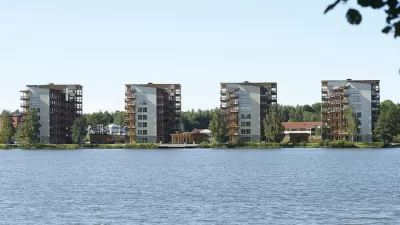A proposed development in in the North Loop section of Minneapolis would be the first of its kind. According to the architect behind the design, the "T3" project, as its known, could be a harbinger of buildings to come.
Peter Callaghan begins his coverage of the T3 project proposal by noting its singularity. According to Callaghan, "if the seven-story, 210,000 square foot office building is completed, it will not only be one of just a handful of tall buildings in the world made primarily of wood — it will be the first such building in the United States."
The article goes into suprising detail in explaining the engineering and design components of the project. According to Callaghan, "the proposed design isn’t simply a concrete and steel building with lots of wood trim and accents. It is fundamentally different — a building made of wood. And those who are expecting a 21st century version of the structures that remain dominant in the Warehouse District will be disappointed or surprised. Those massive, old-growth timbers used a 100 years ago (think the interior of Butler Square) aren’t much available anymore. Instead, the material to be used in T3 is modern, what architect Green calls 'new-technology wood' or Mass Timber construction." There are a lot more details to peruse in the article.
As for how the T3 project relates to a larger trend in the building industry, and its implications for zoning codes and planners everywhere, the article also discusses the politics of the project's lead architect, Michael Green of Vancouver. Green is somewhat of an evangelical for wood construction, presenting his case in a TED talk (below) and a manifesto of sorts, titled "The Case for Tall Wood Buildings" [pdf]. If you're looking for evidence that city's are ready to embrace wood for more and bigger kinds of buildings, Toronto recently approved changes to its building codes to allow construction of wood-framed buildings up to six stories high.
Hat tip to Jenn Stanley of Next City for the link to the MinnPost's coverage.
FULL STORY: Minneapolis' office building of the future will be made of, uh, wood?

Study: Maui’s Plan to Convert Vacation Rentals to Long-Term Housing Could Cause Nearly $1 Billion Economic Loss
The plan would reduce visitor accommodation by 25,% resulting in 1,900 jobs lost.

North Texas Transit Leaders Tout Benefits of TOD for Growing Region
At a summit focused on transit-oriented development, policymakers discussed how North Texas’ expanded light rail system can serve as a tool for economic growth.

Why Should We Subsidize Public Transportation?
Many public transit agencies face financial stress due to rising costs, declining fare revenue, and declining subsidies. Transit advocates must provide a strong business case for increasing public transit funding.

How to Make US Trains Faster
Changes to boarding platforms and a switch to electric trains could improve U.S. passenger rail service without the added cost of high-speed rail.

Columbia’s Revitalized ‘Loop’ Is a Hub for Local Entrepreneurs
A focus on small businesses is helping a commercial corridor in Columbia, Missouri thrive.

Invasive Insect Threatens Minnesota’s Ash Forests
The Emerald Ash Borer is a rapidly spreading invasive pest threatening Minnesota’s ash trees, and homeowners are encouraged to plant diverse replacement species, avoid moving ash firewood, and monitor for signs of infestation.
Urban Design for Planners 1: Software Tools
This six-course series explores essential urban design concepts using open source software and equips planners with the tools they need to participate fully in the urban design process.
Planning for Universal Design
Learn the tools for implementing Universal Design in planning regulations.
City of Santa Clarita
Ascent Environmental
Institute for Housing and Urban Development Studies (IHS)
City of Grandview
Harvard GSD Executive Education
Toledo-Lucas County Plan Commissions
Salt Lake City
NYU Wagner Graduate School of Public Service




























